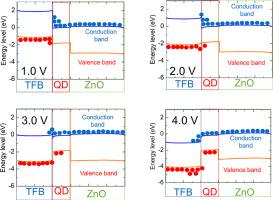Organic Electronics ( IF 2.7 ) Pub Date : 2020-08-17 , DOI: 10.1016/j.orgel.2020.105865 Shoichi Sano , Takashi Nagase , Takashi Kobayashi , Hiroyoshi Naito

|
Efficiency limiting factors of quantum dots light-emitting diodes (QLEDs) are studied by means of a machine learning approach using features taken from published data. Prototypical structure of QLEDs studied here is transparent conductive oxide (TCO) (anode)/hole injection layer (HIL)/hole transport layer (HTL)/quantum dots (QDs)/electron transport layer (ETL)/Al (cathode), which can be fabricated by printing processes. The most important efficiency limiting factor manifested from the machine learning is the hole injection barrier from HTL to QD layer, and the energy barrier reported in literature is about 1 eV in CdSe QDs based QLEDs. A mechanism of the hole injection in such QLEDs is examined by means of device simulation. Other efficiency limiting factors - the electron mobility of HTL and carrier balance in QD layer - are shown on the basis of the device simulation results. The importance of the efficiency limiting factors are experimentally confirmed, indicating that information concerning the electronic transport properties of HTL, QD layer and ETL is essential for the design of QLEDs by means of machine learning approach.
中文翻译:

固溶处理的量子点发光二极管的工作机理和效率限制因素
量子点发光二极管(QLED)的效率限制因素是通过机器学习方法,使用从公开数据中获取的特征进行研究的。本文研究的QLED的典型结构是透明导电氧化物(TCO)(阳极)/空穴注入层(HIL)/空穴传输层(HTL)/量子点(QD)/电子传输层(ETL)/ Al(阴极),可以通过印刷工艺制造。机器学习中表现出的最重要的效率限制因素是从HTL到QD层的空穴注入势垒,文献报道的能垒在基于CdSe QD的QLED中约为1 eV。通过器件仿真检查了这种QLED中的空穴注入机理。根据器件仿真结果显示了其他效率限制因素-HTL的电子迁移率和QD层中的载流子平衡。通过实验证实了效率限制因素的重要性,表明有关HTL,QD层和ETL的电子传输特性的信息对于通过机器学习方法设计QLED至关重要。











































 京公网安备 11010802027423号
京公网安备 11010802027423号